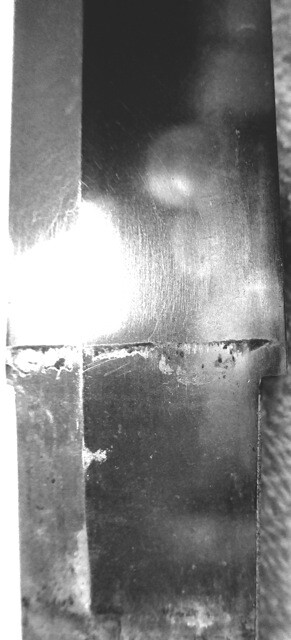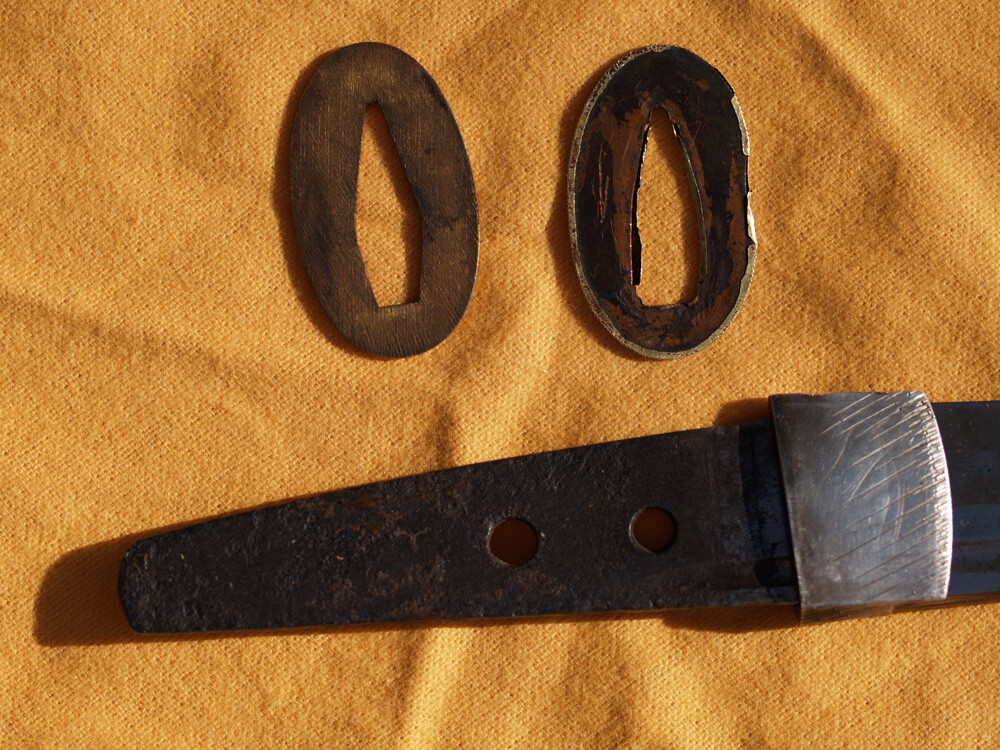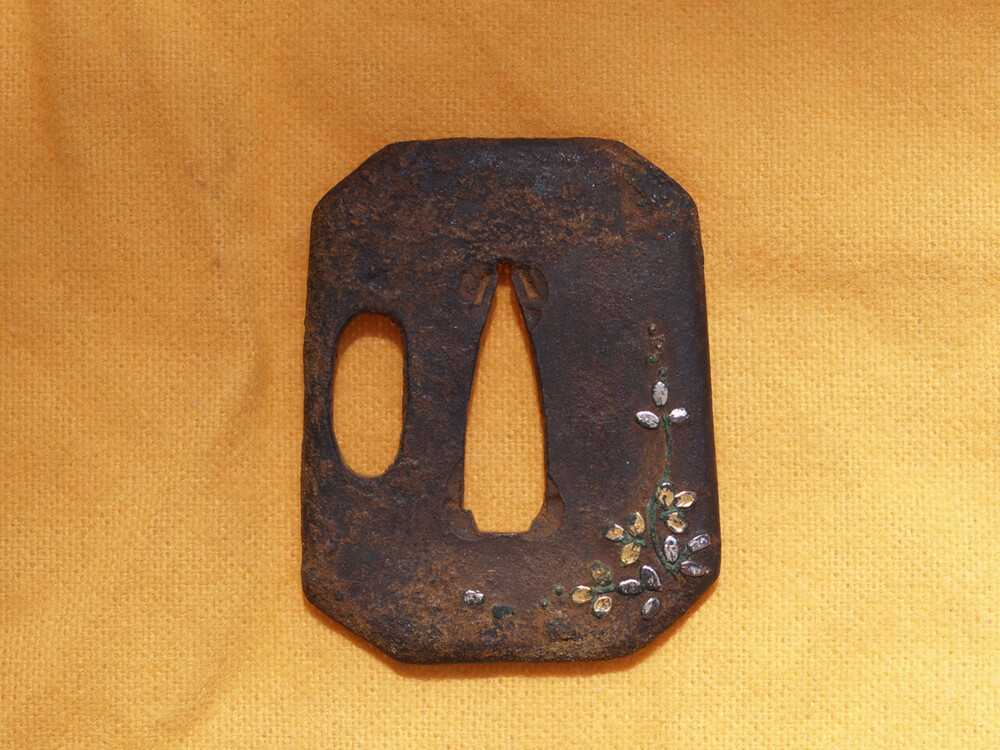
Robertex
Members-
Posts
74 -
Joined
-
Last visited
Content Type
Profiles
Forums
Events
Store
Downloads
Gallery
Everything posted by Robertex
-
As requested, I just received the following photos. I recall the painted characters on the nakago were difficult to see in person and the photos appear just as elusive. The second set of photographs are the same except one is filtered in an attempt to pick out the polish extending beneath the habaki. My friend says that the polish extends about 1/4" past the habaki line (the green crud). I can't thank you enough for the generous responses in evaluating this blade. It has certainly been a learning experience for me so far.
-
Brian, Many thanks for your response. Realizing one can examine Nihonto only so much through photos, is there any area in particular to photograph in order to narrow it down to a Gendaito? I've asked my friend to photograph the paint on the nakago, which may be difficult because I remember it being very faint.
-
Mark, Attached is what he has sent so far. I've asked for a photo of the nakago with the painted markings and will post as soon as he provides it. The blade measures 26.25" (60.96cm).
-
A friend stumbled across and purchased a GI gunto bring-back while at a private bonsai sale and asked me to help with its identification. I'm a bit rusty (no pun intended) on Nihonto and know absolutely nothing about WWII gunto. I did examine the nakago and it is mumei; however, there are superficial markings on it that I have never seen and am assuming it is peculiar to WWII gunto. My friend is taking photos now of the sword and I would like to ask this esteemed following about what areas he should concentrate on other than length, hamon, boshi, nakago, and general koshirae. The sword is in immaculate condition and my friend trying to establish contact with the veteran who is in a local VA regarding its provenance. Many thanks in advance!
-
-
-
Gents, Many thanks for the quick responses! I'm still trying to get a photograph of the jingasa's left side, so bear with me. In the meantime, by coincidence, the gentleman archiving the art objects sent the attached photos. The jingasa looks pretty rough, but still interesting to a novice like me.
-
We had an unfortunate loss in my in-law's family and among the fine art was found the attached Jingasa. I only have the one photograph so far, but would like to know if anyone can identify the period or any other attributes, as armor is well outside of my expertise. Kind Regards, Carl
-
David, I took some quick pics of the tanto to help confirm it as late Edo. Again, not in the greatest of shape.
-
David, Thanks for the thoughtful response. The small pieces of ivory that I am using are great for navigating around the inlays. I will press on with the rust removal and hope there is minimal pitting. Most of the flat area I have completed has a great patina; however, I'm not so hopeful with the reaminder. I will be sure to post photos when finished. Thanks again.
-
Attached are photographs of a small tsuba that I am having trouble identifying and would greatly appreciate any assistance from this esteemed membership. Perhaps part of the problem in identification is that it could be Chinese or a tourist trinket. As you can see it has a fair amount of rust which I have been diligently removing with the top face an old piano key. Needless to say the rust removal has been a long process, although curiously satisfying. However, I would like to know more about this piece before dedicating a more time and sweat.
-
Tom, Many thanks for your response. Do you have any trusted sources for Echizen Kinai tsuba?
-
Still researching a suitable tsuba for a Yasutsugu/Shinto Tokuden blade, and would greatly appreciate any photos of examples from that period to help me focus!
-
I've been going at a tsuba with a piece of ex-piano key ivory using Jim Gilbert's tried and true method, and would greatly appreciate your recommendations on a type of artificial light to examine progress, as well as viewing Nihonto in general. Obviously sunlight is the best, but my schedule often precludes working on this art during daylight hours.
-
As always, many thanks for the expert advice! The katana I'm considering finding a tsuba for is an average Yasutsugu (Shinto Toku Den) in old polish. Nothing really to write home about, but decent enough and my only papered katana. I'll try to get a few pics of it, but absent of that, any initial thoughts on tsuba?
-
I'm curious if collectors search for tsubas to match up with favorite katanas in their collection, and if so, what are the criteria? My interest in this topic is that I have a documented blade in shirasaya and remnants of koshirae, but no tsuba. I think it would be nice to find a tsuba in order to display the full koshirae with tsunagi. Katana shin and tsuba are discussed so commonly in absence of the other that perhaps it is unrealistic or even hokie to consider reconstructing a representative katana from a particular era. Thoughts?
-
It's in my rearview mirror now... thanks guys!!
-
I would greatly appreciate expert eyes on the attached photographs of a shinchu (?) tsuba to confirm if it is a casting/fake. There is a fair amount of what appears to be flashing in the various ana of the design which indicates to my untrained eye a casting type process. My photography skills are not up to what I've seen in this group, but perhaps good enough to reveal the integrity of this particular tsuba.
-
Thanks David and Bob! I've read and re-read the articles, ordered some materials, and will move out on this project slowly and smartly. I'll post pics when finished.
-
I would greatly appreciate advice on cleaning the small tanto tsuba in the attached photographs. Although I have read several posts on cleaning with bone/ivory and horse hair brushes, I have yet to attempt any of it, especially on such a delicate piece. The photogaraphy is a bit shakey, but should give you an idea of the extent of the rust. Many thanks in advance.
-
Thanks Chris and Keith! I've been looking for two-sword stands that are simple and dignified in design that won't detract from the saya and koshirae. Do you have any recommendations or examples you can point me to?
-
How much attention should we allow for koshirae? The few Nihonto I have are eqiupped with tsuba and koshirae; however, the majority of focus is on the kami. I'm still in the novice stage and display my collection in their livery, but not naive enough to realize that the koshirae may not be original and fabricated/fitted at a later date. I'm starting to ramble here, but what are your thoughts on assessing and preserving koshirae (vice commiting the blade to shirasaya) when there's so much to study about the blade? Should I strip the tsuba off as a stand-alone collection and discard the koshirae, or display the blade in shirasaya with its koshirae and tsunagi? This is probably all personal taste, but then again, the new guy here is trying to focus.
-
Many thanks as always with the world class (literally) assistance! Just received my copy of "Connoisseur's" to study and add to the bookshelf. However, I am a realist and accept the fact that only so much can be gleaned from written material and photographs. Perhaps the best venue for the student is actual face time with various experienced collectors and their collections over many sessions. When I was just starting out in the early nineties there was a "society" in Richmond Virginia (USA) that met frequently to display and discuss Nihonto. I attended the meetings and subscribed to the local newsletter, but was intimidated by the collections. I look back now and wish I had injected myself into the discussion as a confessed novice. Unfortunatley, contact info has long expired and there is no joy in locating old members. If anyone out ther has knowledge of a like organization in Virginia, please let me know!


























